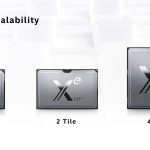During Intel Architecture Day 2020, Raja Koduri and other Intel architects shared interesting new details about what they are working on. We already covered some of the Tiger Lake news, but there's also new interesting on Intel's Alder Lake and Xe-HPG architectures.
Beside the Tiger Lake and Willow Cove core architectures, and SuperFIN and SuperMIM technologies, Raja and the rest also talked about Xe Graphics and Alder Lake architectures, packaging, Ice Lake and Sapphire Rapids as data centre architectures and the One API Gold.
Starting with Intel Xe-LP, this low-power microarchitecture targets mobile platforms with its very efficient performance. With up to 96 EUs, asynchronous computing, view instancing, sampler feedback, updated media engine with AV1 and updated display engine, Xe-LP will come with new features such as instant game tuning, capture, and stream-and-image sharpening. Additionally, XE-LP drivers will be improved with DX11 path updates and a revised compiler.
Intel Xe-HP was also mentioned, stating that the first Xe-HP chip “has been powered on and back from the labs”. According to Intel, Xe-HP is the industry's first “multi-tiled, highly scalable, high performance architecture”, making it a data centre-class GPU solution. Featuring one tile, to two or four tiles, Xe-HP chips will work similarly to a multicore GPU. Intel showed a single tile chip handling 10x 4K@60FPS streams and the scalability of Xe-HP architecture across multiple tiles. Intel Xe-HP will be available next year.
The last Xe Graphics architecture is the Xe-HPG featuring hardware ray-tracing and GDDR6 memory. Optimised for gaming, the Xe-HPG will take the performance per watt ratio from Xe-LP, the scalability of Xe-HP, and the frequency optimisation from Xe-HPC. This microarchitecture is expected to be available in 2021.
Regarding Alder Lake, Intel confirmed that its next-generation client platform is a hybrid architecture. Using Golden Cove big cores and Gracemont small cores, Alder Lake will be optimised for “great performance per watt”.
Intel staff also talked about its new hybrid bonding technique as an alternative to the conventional “thermocompression” bonding. Hybrid bonding allows aggressive bump pitches of 10 microns, increasing the interconnect density and bandwidth, and reducing power consumption.
Intel confirmed that Ice Lake will be used on Intel Xeon Scalable processors, available later this year. With up to eight memory channels, PCIe Gen4 support, this new technology will be used in IoT and network storage devices. Sapphire Rapids will be Intel's next-gen Xeon Scalable processor architecture, and it will be using a new built-in AI accelerator called Advanced Matrix Extensions and SuperFIN technology. This new architecture will support DDR5, PCIe Gen5, and Compute Express Link 1.1. Sapphire Rapids is expected on H2 2021.
Finally, we have Intel OneAPI Gold, available later this year. OneAPI is a unified programming model that provides a universal developer experience across CPUs, GPUs, FPGAs, and specialised accelerator architectures. The last OneAPI beta (eighth iteration) was released in July and brought new features with it, including “enhancements for distributed data analytics, rendering performance, profiling, and the video and threading library”.
KitGuru says: Have you watched the Intel Architecture Day 2020 event? What are you most excited about? Will Intel Xe-HPG architecture be able to rival the likes of AMD and Nvidia?
 KitGuru KitGuru.net – Tech News | Hardware News | Hardware Reviews | IOS | Mobile | Gaming | Graphics Cards
KitGuru KitGuru.net – Tech News | Hardware News | Hardware Reviews | IOS | Mobile | Gaming | Graphics Cards








